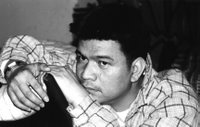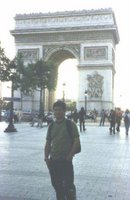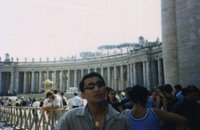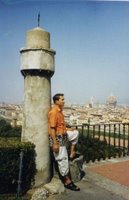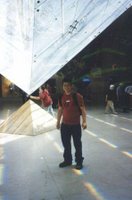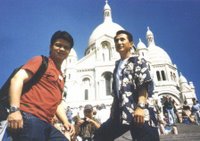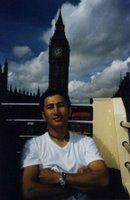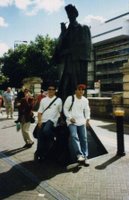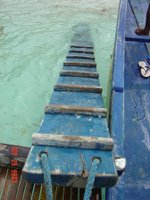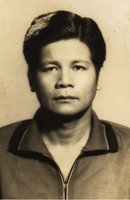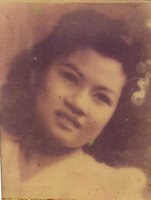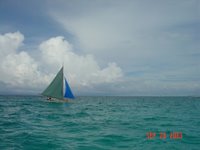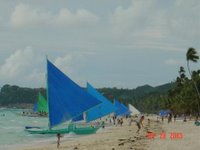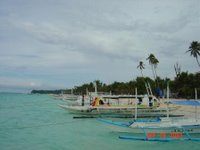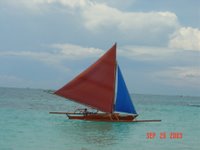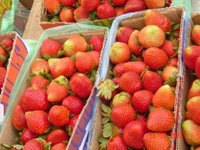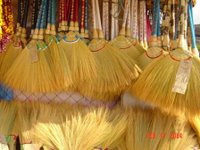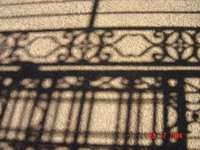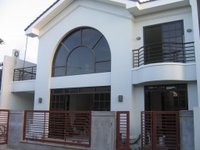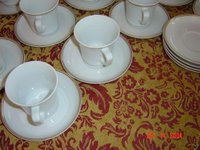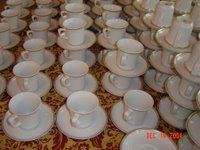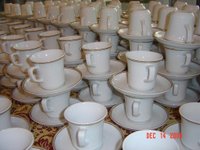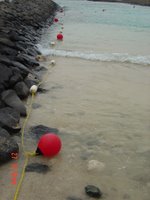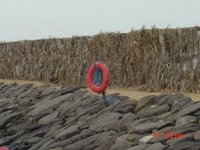Monday, July 31, 2006
LIFE LESSONS 2
We sometimes engage in light banter as well as in serious talks, specially during tense times when I find myself in the middle of a sticky situation brought about by clashing egos and personalities with co-workers.
The life lesson I learn from him during these times would be akin to Richard Carlson's "Don't sweat the small stuff." In his own paraphrase, he will urge me to let matters or issues or bad words or actions slide, specially if it came from a person I don't have to care about. He adds that that particular offending and offensive person may be gone tomorrow, for all I know. So why be too bothered?
One must be bothered or affected somehow. It is human to be so. It helps you avoid being callous. To flex your sensitivity muscles. But the life lesson here is that while it may be human and normal to be affected to a certain degree, to be consumed and obssessed is no longer normal even if it is still human. So cry just a little and not a river.
And forgive slights but selectively forget. One always needs to learn the lesson.
Sunday, July 30, 2006
LIFE LESSONS
Pero bumabalik sa akin ang nakalipas na ito kasi me sumundot e. Me nabasa ako. Naisip ko tuloy, i-blog ko kaya yung mga truisms sa buhay ko na kahit hindi ko naman pinag-isipan ng todo o ng mabuti, e lumulutang pa rin sa consciousness ko, at lalo na sa actions ko? Parang mga philosophies and principles in life na naging gabay ko sa buhay. Yung mga tumutulong sa akin para magpatuloy akong mabuhay at hindi maramdamang walang saysay o katorya-torya ang buhay ko.
Mga life lessons kumbaga.
Nung nasa public grade school ako, yung teacher ko sa Science class, palagi na lang ikinukwento ang daughter nya. Isa sa mga kwento nya about her was kung papano nya i-instill ang sense of discipline in her daughter. Simple lang approach nya. Lagi nya lang daw sinasabi sa daughter nya na ibalik ang lahat ng bagay kung saan nya to kinuha. Yun bang pagtayo mo from a chair sa isang kainan e you promptly push it back?
Nung nasa academe naman na ako (this was mga 1984; I immediately got employed in a private school after graduating from college in April), I witnessed this scenario of one of the school officials who I naturally gravitated to kasi mukha talaga syang mabait, who wanted to make a call pero she was outside of her office and could only do it by using someone else's phone (landline; di pa uso cellphones nun). The great thing about it was that she asked permission first if she could use the phone unit, despite the fact na high-ranking school official sya and you would expect na hindi naman na kailaingang gawin nya yun. Pero the life lesson was clear: courtesy is expected from everyone.
Corollary to this experience, nagkaroon naman ako ng co-worker (she was a teacher), na who would never sit down on her boss' chair kahit na wala naman ang boss sa office. At least not deliberately. I mean, kung talagang wala nang ibang choice.
The prayer of St. Theresa of Avila also resonates with me well. Di ba ang sense nung prayer is that "all things pass?" Yung mga ala-"everyday is another day." It teaches me optimism, lalo na pag down na down talaga ako. Pero kasabay nito, ang dasal ko lagi ay for more grace to persevere while going though the hard time.
Unbelievable but true pero si Sherlock Holmes ay kinapulutan ko din ng aral. Isa sa mga stories about him lets him ask his assistant kung ilang steps meron sa staircase na dinaanan nila just recently. Siempre, si Watson clueless. E sino nga naman ba ang mag-aaksaya ng panahon? Pero my dear Watson, ika nga, that precisely is the point! Maging observant lalo na of the bagay-bagay na commonplace. Tipong "stop and smell the roses?"
Lately, paborito ko itong life lesson na halaw sa isang sinabi daw ni Toni Morrison (Nobel laureate for lit; one of her most notable novels is 'Beloved' which Oprah made into a TV-movie). Sabi nya, and I read it of all places, sa isang issue ng Reader's Digest, na hindi daw dapat i-pursue ang happiness sa buhay. Instead, ibuhos ang buhay sa pag-share -- time, talent, love, wealth -- with others. Kung maging happy ka, it's a bonus. Pero the pursuit of happiness is not the end-all and be-all of your life. Sharing is.
Dati, naku-cute-tan lang ako kaya I would quote Blanche Dubois' (T. Williams' A Streetcar Named Desire) line: "I have always been dependent on the kindness of strangers," or something to this effect, pero sobrang tugmang-tugma ang quotable line na to sa buhay ko kaya relate na relate ako. To the point na kahit to strangers, I can afford to be generous, lalo na to the so-called little people. After all, kahit naman panloloko lang naman pala ang modus operandi ng iba sa paghingi ng tulong, iniisip ko lang ang words naman na binitiwan diumano ng Dominican saint na si St. Martin de Porres. Yung, "they may have robbed you of your money, but they did not rob you of your charity."
Siempre, hindi naman ang mga ito lang ang life lessons for me. Madami pang iba. Hayaan nyo, pag naalala ko sila, ibo-blog ko din sila.
Saturday, July 29, 2006
RR [Cooking ng Mamay Ko]
August 18, 2002
Our neighbor in Daraga, Albay, the tailor, once had a maid we called Belen. She was not a whiz at cooking but we would gobble up a lot of what she cooked. The tailor's kids and us were playmates. As such, we would go "neighboring" in each other's homes from time to time. When Belen was done with her cooking and it's her wards' time to eat, she would let us eat as well. One time, we mentioned this to Mamay (my mother) and even added that Belen cooks really well. Uncharacteristically, Mamay shot back: "She's not the only one who cooks well, huh. I cook well too."
Mamay indeed cooked well. She always cooked with the freshest ingredients there were since we only lived a stone's throw away from the palengke, thus negating the necessity for a refrigerator. She also had quite a large brood to feed that our long narra dining table would always be full. This table once had a glass cover on top and we would sometimes insert photos underneath. But everytime something spilled on the table, something always seeped through to the photos. The photos would of course be ruined and would even sometimes stick to the glass. The glass would also crack and chip off at certain points. It was considered bad luck to have broken glass at home. The glass had to go. As substitute, we would have fancy plastic table covers or place mats. These would smell though even after a damp piece of rag had been used to clear debris after a meal. Later, the long narra dining table was used uncovered.
Mamay would be at her cooking best specially when Papay was home from his base in Tondo, Manila, from where, as far as our business enterprise then went, he would send vegetables and fruits he would get from Divisoria and ship them all by train to Daraga for Mamay to sell. Papay would plane in at least once a month from Manila to Legazpi where the nearest airport was. One memorable experience from Papay's airplane rides would be when he would let us feast on his pasalubong --- the ham sandwich and candies that passed for food served to him on the aircraft. Philippine Airlines was the only airline then that flew to Albay.
With Papay around, there would be the finest nilagang baka on the table, with its rich and yummy broth and the utak ng baka (actually the bone marrow) competing for Papay's attention and ours, with the greenest pechay, the most tender cubes of Irish potato and the sweetest saging na saba. A dash or a platito of Rufina patis (fish sauce) would go best with the nilagang baka. Fresh boiled rice would complete the meal.
Because we were really a proletariat family and not really from alta sociedad, we did not begin our meals with soup or salad nor end it normally with dessert. However, if we had fruits in season at the sari-sari store, Mamay would serve sliced mangoes or watermelons for panghimagas. Otherwise, it would just be papayas or bananas, either the lakatan or latundan variety.
If Mamay had the time, she would whip up her version of halayang ube, made of mashed Irish potatoes which would have gone to waste had we not cut out the rotting parts. She would add violet food color to turn the mashed potato into the color of ube. She would add kakang gata and condensed milk as well. And she would stir and stir and stir until her arms would want to give up. As the mix thickened, it became harder to stir. And stir she did so as not to burn the mixture. Once the desired consistency was reached, Mamay would then let the mixture cool and transfer to a bandehado. She would also start on slow cooking the rest of the coconut milk left over from the kakang gata to make latik which she would then generously lavish on top of her version of halayang ube.
Another favorite home-made dessert would be mango jam. Once again, we would set aside mangoes with patse or darkened skin specially at the top, which would be our palatandaan that the mango has started to rot . We would cut out this portion and retain the still edible parts. We would slice it off the mango seed and boil it with white sugar. As the mixture thickened, we would take it out of the fire to cool. We would then have dessert or even palaman for hot pan de sal for breakfast.
Tamarindo would also be part of Mamay's home-made cooking menu, although most of the time, we would rather sell it bottled like jams or wrapped in clear cellphane like candies. Tamarindo would be cooked the way we cooked mango jam. All we had to do was boil the tamarindo in a mixture of white sugar and water and stir so frequently to keep the mixture from getting burnt. At the mixture's desired consistency, we would take it off the fire to cool. They would then be transferred to recycled Lady's Choice sandwich spread or peanut butter jars to be sold to classmates. They became bestsellers that sometimes, my sisters' classmates from the upscale St. Agnes' Academy in Legazpi City would drop by our sari-sari store to be first to buy their share.
Apart from nilagang baka, which was one of Papay's favorites, Mamay would also cook sinigang --- hipon, bangus or baboy. Mind you, hipon would be sugpo, bangus would be the fattest and baboy would be liempo or ribs --- just about the premium cut or type. These would have the freshest sahog as well, from the labanos to gabe, to sitaw and kangkong. Since instant sinigang mix was not yet available and popular then, she would invariably let these ingredients simmer in kamias, sampalok, tomato or guava for the asim ng sinigang.
Sinigang na kabute sa bayabas would also be another deliciously sour variant. Mamay would simply add slices of pork liempo to the simmering mix of fresh mushrooms and guavas and voila, another sumptuous ulam at the table.
Prinito would also be another way that Mamay cooked food. Mamay would deep fry fresh dalagang bukid or galunggong. Specially for Papay's sake, she would fry maya-maya or lapu-lapu for escabeche. After cleaning the fish of innards and scales, Mamay would simply slather rock salt over the fish and deep fry them in fresh vegetable oil. Mamay rarely re-heats oil already used although there would be recycled coffee jars by the stove for such --- one for oil used to fry meat and another one exclusively for oil used to fry fish. In the case of the escabeche, Mamay would just make a dash for her ample stocks of carrots, onions and bell peppers at the sari-sari store to garnish the escabeche with. She would simply add cornstarch to the mix to thicken the sauce.
Fried meat usually was pork chops or chicken. Mamay would again simply slather rock salt on the pork chops or marinate the chicken in patis and lemon juice.
Anything fried would have vegetables for a side dish. Mamay would sometimes steam okra or camote tops on top of the boiled rice. As long as there would be sawsawan of bagoong alamang and suka or halubaybay and lemon, then the steamed vegetables were ready to give the prito a run for your stomach's fill. If gulay Baguio were in abundance, we would have chop suey with peeled shrimps or fried pork bits for the veggie dish.
Nilagang baka was not the only beef dish at our table; it would also appear in the form of bistek. But when Mamay once had the opportunity of eating at a fast food shop at the old Makati Commercial Center years ago and before the advent of the Greenbelts and the Gloriettas in the mall scene, she could not forget how tasteful the Korean beef steak that she had eaten. She copied the recipe as far as her tastebuds could remember. She guessed as much that the recipe had sugar because the sauce was sweet and so she included a dash of sugar to the sauce and topped the meat off with freshly sliced white onions of which her sari-sari store also had plenty of.
Apart from anything nilaga or prinito, we would also have adobo, inihaw, or binuro at one time or another. Adobo would almost always be pork; chicken was not so much used for this recipe. Inihaw would either be pork again or hito. Barbecued meat was not part of Mamay's cooking fare (but tocinong baboy was; salitre was still the popular curing mix then) although we could buy them from ambulant or roadside vendors. Binuro (usually tilapia or mustasa) would be a rare treat as Mamay would not do it herself but simply buy wherever she can get them. Not that I relished them; I could not stand the smell.
Shrimps and fish were not the only fresh seafoods our tastebuds became acquainted with. Mamay would also sometimes foray into other forms of crustaceans such as alupihang dagat or lobsters. I don't know if squids are crustaceans but we also had them too. I would sometimes buy these and even the meat myself if Mamay cannot make the trip to the isdaan or the karnehan, so I somehow learned to distinguish which were fresh from the hilado.
Estofado would be another one of Mamay's culinary treats for us. She would boil pig knuckles in a mixture of vinegar and soy sauce till these were tender. She would spice up the flavor with dried laurel leaves, dried banana flowers and black pepper. Her secret ingredient would be a dash of sugar that would caramelize and darken the sauce as well as make it sweeter.
The Bicol region is known for its prevalent use of coconut milk and siling labuyo in its cooking but Mamay was never really influenced by these twin ingredients although we would sometimes have ginataang sitaw or sigarillas with a generous dose of fried bits of pork as sahog.
If there was an exotic specialty in our eating fare, that would be kandengga, which is known as bopis elsewhere. Pig lungs and heart would be boiled till tender and chopped (by hand and not by a food processor which were not yet in vouge then) and sauteed and simmered in vinegar and many other spices. Mamay was not the first to serve us this dish; we had it first from a neighborhood restaurant. My tastebuds are suspect of course but Mamay's version of the kandengga was never malansa.
Fiesta fare, on the other hand, would be the usual menudo, embotido, morcon, lechon, rellenong bangus or rellenong manok. Sometimes there would also be steamed lapu-lapu buried under a thick layer of mayonnaise and chopped bell peppers. As far as I can recall however, Mamay never prepared much for fiesta, which in Daraga, falls on September 8, the feast of the Virgin Mary. She must have contracted some other people to cook an incredibly huge amount of food to be served to neighbors, suki, pechay or mustasa farmers from whom she would buy vegetables to send to Manila specially in times of typhoons and flooding, our school mates and friends, and even people we did not know but who came anyway because it was fiesta. Leche flan would be the major dessert at these fiestas.
Christmas would not be that super special for us. Mamay though would make it a little different by having ham, queso de bola, apples and castanas on the table.
For other special occasions however, such as a birthday celebration, Mamay would see to it that she would at least cook sopas for us. Or else, she would make it a point to have home-cooked or restaurant-bought pansit, with white (rye or brown bread was not familiar then) sliced bread on the side. Sometimes bread slices would have Lady's Choice sandwich spread or margarine or Reno's liver spread sparingly on one side; these slices were paired off and wrapped in colored paper napkins. This passed for sandwiches. I would have an inkling that sandwiches could have hamburger patties garnished with thin cucumber slices only when a high school classmate's parents shared with us these sandwiches for our snacks while taking the National College Entrace Examinations in the late 70s. Pineapple juice, diluted with so much water, but sweetened with almost a kilo of sugar and cooled with chunks of ice water (water frozen in slender plastic bags also used for ice candy, i.e., frozen milk and water flavored with mango, avocado or melon bits) would pass for drinks.
Cakes were never part of our birthdays. The first time I ever had a cake was when I turned 7 years old. We were spending our summer break in Nueva Ecija then, as was our wont during those days, traveling to Manila from Albay via the trains. Our dikong Berto, a distant relative who at one time came under the care of Papay, and who considered Papay a surrogate father after that, worked at the Manila Hotel as waiter. I sort of became a pet nephew of his since I shared his nickname somehow. When he found out that it was my birthday, he came home with a big box of a gift to me. I kept asking what was inside the box but no one would tell me. But when I would shake the box to better get an idea what was inside, they would scold me to stop shaking it. It turned out the box had a round cake inside complete with frosting of lard which of course stuck to the box from my vigorous shaking. I do not remember blowing any candles; maybe there weren't.
Mamay sometimes also brought us cakes of the round chiffon/sponge type with the huge hole in the middle and without the icing. A variation would be a cake with glazed pineapple slices on top. Sometimes it would be pianono. This would be her pasalubong to us specially after she has been gone for almost the whole day which she spent in the farms of Bigaa, Arimbay or Sto. Domingo buying the farmers' vegetables. As soon as the vegetables have been loaded into the trains, she would head back home with the cake. Sometimes, she would also bring us this delicate-tasting pastillas that were packed so slim you would mistake them for sticks of cigarettes.
If Mamay could not cook, at first because she was quite busy at the sari-sari store or at the farms, and later because she must have started to become uninspired, we would do the cooking ourselves specially since we were already old enough to be in the kitchen. When we were younger, participation in the kitchen consisted of washing the dishes, pots and pans. We would do the washing by turns as there were many of us to do it and not too many of us want to do it. This and sweeping the floor constituted what we described in class as household chores.
Cooking by ourselves most likely happened during breakfast when we would invariably cook fried rice to accompany whatever was left over of last night's dinner. In the absence of a refrigerator then, the left over food would of course be kept in the platera that stood so uncomplainingly between the long narra dining table and the door to the kitchen. There were also times when we would try our hand at fying eggs, tocino or dried fish. Or simply heap condensed milk on unsuspecting hot pan de sal. We'll wash down breakfast with Ovaltine or Milo. To perhaps the chagrin now of milk lovers everywhere, we weren't used to drinking milk even then. Osteoporosis was not yet part of the health-conscious lingo that time.
For lunch and dinner fare, we would check out what our neighborhood eateries had to offer. Our favorites would include the tinuktok (ground pork sauteed in its own mantika with achuete and green peas) which we would buy from the eatery owned by a Chinese family, many of the home-cooked style food including the legendary laing, the famed Bicol express, the best halu-halo from Palamigang Bayan just near the intersection of Regidor Street and the town's main thoroughfare, and pansit of flat noodles from the rows of carenderia across our street. At dusk, ambulant or roadside vendors would start selling pinangat of shredded gabi leaves tied with strips of banana bark and filled with flaked fish or minced pork. Tahong dipped in orange-hued batter and deep fried was also a staple at this time, not as ulam though but more as food-between-meals.
Mid-afternoon was time for Mamay's ginatan, a rich mix of sliced saging na saba, chunks of sweet camote or cassava and fresh strips of ripe and sweet langka swimming in thick coconut milk. If Mamay can't serve this, we would just run to the neighborhood palengke and have our pick of sinapot (the Bicolano version of maruya) or kalingking (the Bicolano french fries but made of sweet camote strips). Interestingly, these snacks staples would be sliced and dipped in a simple batter and arranged side by side on top of an unfamiliar leaf and then deep fried. The leaf can be fried again and again and would only lose its shape and form after about a hundred times of being fried. I wish I could have asked the vendors what kind of leaf it was.
Other snacks fare that we would buy at the palengke would be biko, suman, boiled sweet corn, boiled yam strips, balisungsung (glutinous rice cake with bits of coconut flesh and steamed while wrapped in banana leaves), nilupak (boiled cassava or saging na saba pounded manually as grated coconut was mixed from time to time) or bukayo with bits of young soft coconut. Cotton candy, pancakes and "scrambled" (today's version is the shake) were only available during fiestas. Except for cotton candy, we never liked the rest anyway.
Mamay was from a farming family in Nueva Ecija, then as now considered the rice granary of the Philippines. Their family was not of the landed gentry but rather, of the tenant class. This could be the basis for Mamay's distinctly proletariat cooking.
Maybe also due to Mamay's background, our dining table never really had all the food groups represented at every meal. Balanced diet was something we only heard from our Science teachers. Mamay would serve us whatever took her fancy, whatever inspired her, whatever she thought we or Papay would like that day, or whatever was available at the market. But despite such a background, I always felt that Mamay never scrimped when it came to food and letting us eat to our hearts' content even if all we were eating were home-cooked meals and at times, what the neighborhood carenderia had to offer. Fine dining and gourmet food were as far as Pluto was from our real world.
When Mamay died, good food was as scarce as Nido soup from our dining table. Not only did we not have enough money to ensure we were eating three square meals a day, we also lost our Julia Child. But Mamay's cooking lives on. In the memories of my childhood, in my memories of the sometimes noisy but always filling meals we all took atop the long narra dining table and in the meals I cook now which I hope, closely hew to how they would have tasted had Mamay cooked them herself. In the recesses of my tongue, I must be finding ways of thanking Mamay for her cooking. I never did when she was alive; not even when she said she was as good a cook as Belen.
BFF's
What tabloids and bloggers call BFFs -- best friends forever!
In grade school, my friends were the kids in our neighborhood. I had classmates but they were not friends. I had relatives but they were not friends. My neighbors were the friends I played with. After school. After dark. Tumbang preso. Agawan ng base. Luksong tinik. My friends were neighbors who celebrated birthdays by inviting us. These days, our neighborhood friends are distant memories.
In high school, my classmates were my friends. The irony of my high school classmate-friends is that they seemed to have ceased being my friends in college. But what a delightful surprise to rekindle those friendships at reunions after college. In fact, classmates who were mere acquaintances have also become friends.
In college, new-found friends were my dorm-mates and batch-mates. But no one seemed to stick around, except for a very few souls so precious I refuse to let go of them even if I hardly see or speak or email them.
Working right after graduation from college, afforded me even greater opportunities to have friends from the workplace in the Philippines and overseas. But as in college, very few remain precious to me.
People who could become your friends and who may indeed have already become your friends, come and go. But there are those who remain with you despite the distance and despite the years. They are blessings I thank the Lord for always. Together with family and loved ones, my friends have put me in a place that is good -- that stage in life I have plenty to smile about.
BURNING ISSUES
Here's my two cents' worth --
ON GLORIA MACAPAGAL-ARROYO
She should stay and complete her term. I go by the analysis written by Belinda Olivares-Cunanan in her column on the Philippine Daily Inquirer. The election results on which her victory was based, reflected the Namfrel count. Not even the next evaluation of the results prompted by the protest lodged by losing vice presidential candidate Loren Legarda against winning candidate Noli de Castro, and despite her lead winnowed down to only about half a million votes, could dispute the victory. After all, the review was made on the same election results upon which the first announcement of victory was made. If ever there was cheating, it was not sufficient enough to alter the election results. My favorite columnist asked besides (which I paraphrase at liberty), "Who among our politicians never cheated, whether they emerged the winner or not?"
So you wonder why even members of the Catholic hierarchy are getting involved in calls to get Gloria to step down, when through Namfrel, the Church effectively affirmed Gloria's victory?
These calls for her to resign stem from more deep-rooted reasons other than her alleged cheating at the polls.
I never for a second believed the opposition including the leftists and Cory and the Church.
ON THE MIDDLE EAST CRISIS
As well, there is more to this than meets the eye. Israel is not merely retaliating against the Hezbollah for the abduction of an Israeli soldier in an outpost.
But whatever, I say enough. The quarrel between Israelis and the Arabs and the Muslims has gone on long enough. How can't there be a resolution? Why isn't there a resolution to their conflict? Are they not human who can come to an understanding of some sort?
My main goat is this: Their conflict has affected the whole world, that even those who are not parties to the conflict have gotten involved if not affected.
Both sides must stop the conflict before World War 3 ensues. Or before nature takes its course and wipes us all out of the face of the earth.
DREAMS
But first, my Bebe smacked me on my right ear. I of course awoke. It hurt a lot. Later, he told me that he was dreaming that he was fighting with an older sister. He must have struck his sister in his dream. Poor me got struck on his sister's behalf.
Hurting, I moved to another bed.
In my dream, I went away from my Bebe because he smacked me. I found myself in the middle of several bunkbeds that were in turn, very near a huge swimming pool. The beds and the pool were in the ground floor of an apparently huge concrete building. I was talking to disfigured people. They were the survivors of the Ozone disco inferno.
One of them showed me a list of people who already visited them. I was in a list who visited only once. In my dream, it was just my second visit then.
The survivors were housed in that building courtesy of a German benefactor.
On the walls of the bunkbeds were plenty of souvenir letters, cards, drawings, photos and even frames -- all mementos of what appear to be get-well messages, encouragement letters, etc.
Interspersed with this dream was another dream of me preparing myself for a part in a program. My main problem in this sequence was I could not find the dressing room.
Back again to the bunk bed + swimming pool sequence -- I found myself next to an old friend and her kid (It was unclear if the kid was a son or a daughter.) It seemed they were constant visitors of the survivors.
I woke up from time to time since I was worried I might be late in getting up. I would drift back promptly to the same dream when I doze off.
I'm thinking now what brought on these dream sequences. Could it be the few scenes I saw from yesterday's MMK episode with Jericho and Heart where Jericho looked like one of the survivors of the Ozone disco tragedy? Could it be because I had been thinking how Jericho looks a lot like Steve Zandvoss of "Latter Days"?
I said a little prayer for the Ozone victims and survivors.
Tuesday, July 25, 2006
RR [The Toliet of Our Youth]
May 19, 2002
The walls were of concrete, unpainted but darkened by the years. The floor too was of concrete, but at least it was paved, that is why it had a certain sheen not unlike a wooden floor's patina from years of use. The door was of plywood, also unpainted while the only window was the jalosy type made of wood. The window had metal grills from the outside. It had the usual toilet bowl but alas it had no faucets. Its source of water is a pump --- called bomba --- from which we cajole water from the bowels of the Earth (actually, just from the water table) to spout into a balde (pail) by repeatedly and sometimes ferociously working on the pump by hand. Water was stored in tall plastic drums. A corner had a shelf for the shampoo and soap used by everyone who enters the room. This was the toilet of our youth.
It would have been an unremarkable toilet for the fact that it was the toilet I grew up with. And I suppose, I found it to be infinitely better than the one I used during the few summers our family would spend in my parents' province in Central Luzon. That one made for an unforgettable toilet experience. It was an outhouse with walls of sawali. You step into a floor of bamboos; in the middle of the floor was a hole in the ground about a meter deep. You also bring with you your tabo and pail of water, or else.
The toilet of our youth did not have a steady source of water from the manual pump. At times when water is scarce, we would have a variety of other sources, the most etched in my memory of which was our neighboring bakery's water froma mechanical pump. My brother Buboy (who was older by a few months; we were no more than 10 years old) and I would fetch water by the pail from this pump. It was, however, a problem for us how to transfer the water we fetched into the drum inside our toilet. The only logical way to do it was to haul the heavy pail from the bakery to our apartment going through the front doors. That was about a two-kilometer trek.
Or we could improvise.
My brother stacked hollow blocks under our toilet's window; we now could reach the window's ledge. Next he fashioned banana tree barks into half tubes that would run from the window into the drum inside the toilet. Now all we had to do was let the water from the pail run through the half tubes and voila, the drum inside the toilet got full.
In my young mind, it was ingenious as it was fun. Fetching water was no longer the hardest chore of my childhood.
RR [GEM's Enterprises]
July 9, 2002
"Bet, bet, bet, beret, bet."
My mother Mamay, used to wake me up with these sounds while lightly shaking my shoulders or my legs. It would effectively wake me up very early in the morning to open our sari-sari store. Not so much for the shaking but for the fact that I cannot let her do the opening by herself. After all, she was already in her 40's then (and quite sick too, it turned out) and I was already in my teens. This was the time when only Buboy, Tess and I were with Mamay. Doris and Flor were studying in Los Banos, Laguna and Manila, respectively. Frisco was already married then and was living with his wife in Anislag, Albay. Lito and two other brothers were also married already and on their own.
The store also actually was our home. It was one of the doors of a commercial apartment that prominently lined Regidor Street, one of the main streets of the town of Daraga, Albay that bordered the town's crowded marketplace. From our street, Mt. Mayon volcano's famous conic peak could be seen as a picturesque backdrop.
I remember the other tenants in the building. The first two doors were occupied by a bakery which also had a restaurant on the second floor. These were followed by another two doors occupied by a Chinese merchant married to Aling Charing. Our sari-sari store was next. The last door was occupied first by a warehouse and then by a tailoring shop in later years. At first, we were the only family that lived in the apartment. Later, the tailor also housed his own family in their apartment.
But all of us kids of the tenants somehow found a way to bond as playful playmates. I remember being invited to Tess' birthday one time. Tess was one of the daughters of the bakery owner. I was made to dance to "Tiny Bubbles" and "Pearly Shells". Embarassing to recall now but I was not shy then. But as we grew up into adolescence, we grew into our separate ways until we only became nodding acquaintances.
The apartment had two floors with the second floor turned into our veritable living quarters and the ground floor as the store area. The ground floor also had the kitchen and the "toilet of our youth". The apartment used to be a wooden structure but it was gutted down by fire in the early 70's. An entirely concrete building went up in its place like the proverbial phoenix so much so that there was talk the fire was really meant to get rid of the old apartment. We moved twice to nearby apartments while the new structure was being built. We were quite fortunate in that we were able to re-occupy the same berth in the new apartment building.
I remember the apartment as the only home I had in Daraga even if my mother used to tell me that it wasn't the family's first abode in the town and despite the temporary shelters we lived in after the fire. It was the home of my growing up years, and I am sure, it is also memorable for my other siblings who grew up there.
As store opener, I would pull out the huge wooden tables (papag) from the inner sanctum of the ground floor toward the wide patio or the printera of the apartment. The tables would then be filled with a number of equally huge bilao that displayed red bulb onions, yellow bulb onions, Irish potatoes and garlic (which we would painstakingly make himay by the bulb from a braided packaging). If it was the season for tomatoes, we would have them too, on top of huge heads of cabbages, red and green bell peppers, curlicued Chinese pechay, bright orange carrots and hairy/thorny chayote. Fruits of the season would be melons, watermelons and mangoes in summer and apples in December. Sometimes, there would also be siniguelas in summer and castanas for Christmas but very rarely.
These would all come from Divisoria by train (these vegetables and fruits would invariably come from Baguio and from the northern and central Luzon provinces). These were always shipped to my mother by my father who was based in Tondo, Manila. They would come in many a kaing or in a lot of sako. Sometimes, in interesting buslo or in wooden crates. The slats of these wooden crates would be my mother's pamalo every time we kids would be caught misbehaving (which was not very often, angelic children that we were, problem children we were never). She would make us all lie face down on the store's floor and we would all get the same hits. There was no Bantay Bata 163 yet then. Anyhow, despite corporal punishment, we felt that we weren't a bit a victim of child abuse.
Complementing this sari-sari store tableau would be the usual istante on the wall, portable timbangan and the money box. The shelves would have a few bottles of Silver Swan soy sauce or a few packages of sotanghon. Mamay would sometimes wear a delentar (apron-like money holder) around her waist when the store got busy so she can better keep track of the bills. Only coins would be stored in the money box. This money box was nothing fancy; it was in fact just a crudely made wooden rectangular box --- a make-shift cash register more than anything else. But I thank this money box for those valuable coins that allowed me to rent comics after school hours and to watch old movies shown as double programs at Plaza Theatre on lazy Sunday afternoons. I must admit I sometimes made kupit, but at many other times, it was with Mamay's grudging consent.
For a busy sari-sari store, it never had any signage. But one time, when our eldest sibling Kuya (he was actually baptized Dominador but we all called him by this term of endearment; no one else was called a diko, sangko, sanse, or ditse in the family) came home from the USA after a stint in the US Navy, he drew a sign on the store's concrete wall with chalk. He named the store, GEM's Enterprises -- G for Gaudencio, my father's (who we also called Papay) name; E for Emiliana, Mamay's full name and M for Magno. So sentimental that name has become to me that until now, in the recesses of my consciousness, I have this dream of naming my future business endeavors the same way, if they ever materialize.
Growing up, I saw the store flourish. Mamay had a way with clients; they instantaneously became her suki. Mamay's customers came from near and far, from the other vendors from the town's mercado to as far away as Virac, Catanduanes; Matnog, Sorsogon and Masbate. They are sari-sari store vendors in their own right who would re-sell Mamay's by-then exotic merchandise. Our vegetables and fruits were so unfamiliar to our shopping public that some would mistake the potatoes for kamote.
Many well-to-do families, on the other hand, would also do their weekly marketing at our store since they could not get the vegetables anywhere else in the vicinity. I remember seeing Dr. Alberto (an old but well-known medical doctor with silver hair and a very Spanish and regal bearing) many a time alighting from his Mercedes Benz, with a well-dressed younger woman who was always in pants. It was said she wore stockings even while wearing pants because she suffered from a bad case of varicose veins. It was also said she was the doctor's mistress or second wife, and not really the true one. Almost always, Dr. Alberto and this woman would be accompanied by young girls in the blue uniform of St. Agnes Academy. The girls were remarkable in the sense that they wore their long tresses curled like a bunch of black borquillos on their heads.
The Philipine National Railroad (PNR) trains were the only practical means of transporting goods and passengers then. The South Road, as the highway between Bicol (the South) and Manila, was already called then, still wasn't the efficient, safe and modern way it is now. If the trains got stranded due to repairs or damage to the tracks, and if rivers overflowed during heavy rains and the tracks got covered if not ruined, or if Mayon's ashes buried the tracks, then the highly-perishable merchandise got to us almost decayed if not totally rotten. By which time, we would work doubly hard, even into the night, to salvage what we can to recoup all costs. Thus we would cry while peeling off the soft, decaying and almost mushy parts of the onions and sevolleno, dry the wet tomatoes with electric fans while the tomatoes are strewn at every available square meter on the store's floor, and nearly puke from the stench of the rotten cabbage leaves as we chop off those parts fit only for the pigs.
Once, after a really strong typhoon, Mamay came home drenched to the bones. She had to personally supervise picking up her goodies from the train station in Ligao, Albay. The train could not proceed to Daraga anymore because of flooding in the railroad tracks. All I could do was embrace her on seeing her and staying embraced to her even while she was trying to dry up herself with a towel. Looking back, I am now amazed she for once did not shoo me away. She just went on with the business at hand while I was wound around her. She later recounted it to Doris in a letter she wrote to her (Mamay was a prolific letter writer in those days; that must be her way of making up for the loneliness she felt when her daughters went away to college or to let them know how much she misses them; I remember her writing to Kuya frequently too when he joined the US Navy), that "wala siyang ginawa kundi yakapin ako ng yakapin".
As kids, we would do our share of generating business from these re-cycled merchandise by spreading a piece of plastic sack by the roadside during market days (these are the days when Regidor Street turns into a hawkers' paradise) and selling onions and garlic by the tumpok. Some would buy from us because they thought we were so cute --- still so young but already enterpreneurs --- and would pinch our cheeks. Mamula-mula daw kasi. Others would buy but would trick us or cajole us into adding more to the atado. I even remember one surreptitiously sneaking a couple of bulbs into her bayong while I was busy trying to sort out her sukli.
These goodies were as good as new. They were not bulok or leftovers. In fact, one time, we were all surprised when a playmate chewed on a large red onion bulb like he was chewing on a singkamas. While we were all aghast that he ate what we thought was ma-anghang, he simply chewed on because he claimed it was masarap.
The merchandise we all did not like so much was the tamarindo. It was quite popular with some vendors because they could cook the tamarind into candies that they can sell as chichiria. Papay, however, would ship the tamarindo by the sackful, already without the balat and resemble huge concrete slabs used to cover drainage in sidewalks. They would come to us complete with crawling little black insects (we called these bukbok; they're harmless and part of the whole thing) coming out of tamarind seeds. We would re-pack the tamarind into one-kilo, two-kilo and five-kilo chunks for easier retail sales. Doing so was back-breaking manual and menial labor. To ease the hard work, we would usually do the re-packing at night while listening to "Sa Loob ng 24 Oras" and "Mga Mata ni Angelita" on the radio.
Sadly, the once-flourishing business did not do well in later years. This was when Mamay's health seemed to deteriorate fast. A series of typhoons also contributed to the business' decline. But I think, on hindsight, it was the competition that eventually demolished the business.
Mamay's success was the envy of the other vendors so that some of them tried to copy her formula of "importing" the exotic-looking fruits and vegetables from Manila. One or two of them in fact went one better than Mamay by using the South Road to transport the goods. Ferdinand Marcos has improved the road infrastructure by then while the railroad was already in its death throes. Ironically, even as he built highways, he did not do the same to the railroads. In fact, the train would not proceed to Legazpi anymore and would just stop at Camalig. Eventually, Mamay's competitors were doing better than Mamay and even acquired their own trucks for use in the South Road.
I also think Mamay's business acumen failed her at this time. She used to just roll over her capital without thinking of investing in other endeavors or in diversifying her business. She put her eggs all in one basket.
But I could not fault Mamay anything at all. She gave it her best. She gave it her all.
During the boom years, I never for once thought we were poor. I always felt bastante. Mamay served us the best home-cooked food using the freshest ingredients from the store and from the nearby palengke. The karnehan and the isdaan were just a leisurely trek away. We in fact never owned a refrigerator all this time because what we needed, we bought at the time we needed them. Sugpo, kangkong, labanos and sitaw for sinigang; alimasag or lobster for halabos, pork liempo for tocino, veal for Mamay's Korean beef steak, pig knuckles for her estofado, and lapu-lapu for her escabeche.
In the end, the store went kaput when Mamay died. Frisco tried to revive it but he was not successful.
There's another tenant now occupying what used to be our apartment. Aling Charing has downsized his husband's business to one door. The bakery's restaurant has since metamorphosed into a videoke club and then into a billiards hall. The tailor has remained.
We ourselves have moved on although from time to time, nostalgia hits me and makes me cry. For GEM's Enterprises. For Mamay.
Monday, July 24, 2006
PAP14 [When My Bebe Went Parasailing]



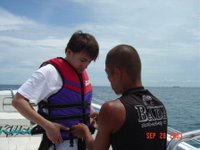
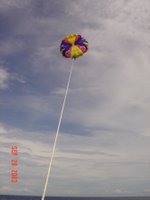 Photographs of my Bebe parasailing over Boracay Island.
Photographs of my Bebe parasailing over Boracay Island.NB. There's no PAP13.
PAP8 [The Me Favorites One]
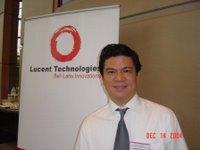

 Photographs of me, moi and myself.
Photographs of me, moi and myself.From the top: Four Seasons Hotel Riyadh, Lake Caliraya and Ataturk (Istanbul) Airport.
Sunday, July 23, 2006
PP [Prayers]
When morning comes, you open your eyes to the sunrise.
You're to thank the Lord, for a deep sleep
and a turn at beginning anew
a new day.
But if perchance you forget,
you ask the Lord to bless you then
as you leave your niche for the world.
That you may have another day ahead
that's free from worries and heartbreaks.
That you may have another chapter
of your life's story full of work and laughter.
As the day wears on,
the Lord comes on to you again.
As you pray for patience in the face of impertinence,
and as you say grace in the face of hunger gnawing.
At the end of the day, the Lord is tops on your list.
To thank Him again for letting you earn your keep.
And as you begin to close your eyes and take your rest
you bid the Lord farewell.
That He may guide you as you sleep and dream,
to see another sunrise again.
21Sept02
RR [My Days as a Jolog]
My Days as a Jolog
June 8, 2002
Jologs ako nun at hindi ko talaga pwedeng ipagkaila. (Kung jologs pa rin ang tingin mo sa akin ngayon, i-cancel mo na ang subscription mo sa GQ 'no!) Kasi naman, nung nasa college ako, I loved wearing this pair of curdoroy pants na baston cut at rust-colored. Pag naglalakad nga ako sa UP campus from the residence hall (I stayed at Kalayaan) to Palma Hall at namumulaklak ang mga firetrees sa daan, blend na blend talaga ako sa kapaligiran kasi kakulay ng pants ko ang mga bulaklak ng mga punung-kahoy.
Fave ko rin nun yung kung-fu shoes. Mura kasi at next best thing siya sa classier na espadrilles which I can't afford at saka hindi ako sanay mag-shop sa Cash& Carry or Cartimar. Meron kasing mga taga-Kalayaan na taga-Pampanga at me access to these PX goods. Yun, bumili rin ako ng isang black pair at isang brown pair.
Saka nun, hindi pa ako aware na dapat ang socks e terno ang color either sa shoes mo or sa pants mo. Keber ko ba? Basta ba me socks ako e hindi ko na worry ang color coordination. (Pero hindi mo naman akong mahuhuling naka-red socks nun 'no.)
Pero kahit siguro pa'pano, me flashes of intelligence din naman ako nun sa pananamit. One time, suot ko yung Collezione ko na navy blue na medyo see through ang effect. Tapos suot ko din ang grey canvas pants. Nagkataon naman na meron akong rubber shoes na grey with navy blue stripes (forget ko lang though yung brand nung shoes ko, pero Adidas yata). Aba, I got compliments sa get up ko huh.
Pero most of the time, clueless talaga ako sa pananamit. Hindi rin naman nakatulong na wala rin akong pambili ng whatever is stylish or in vogue nun. After all, literally iskolar ako ng bayan. I was working in Kalayaan as a resident assistant (R. A.). In return for my services, UP didn't charge me anything for enrolment fee and miscellaneous fees. Me allowance pa akong P150.00 a month. Libre din ang room at food sa dorm.
As an RA, primary role namin ang maging big brother nang mga freshmen. Kaya nga, we check on the freshmen assigned to us (RAs are assigned two to each floor; with two residents per room and with about 25 rooms to each floor, we are kuya to about 50 young men) every night to see if everyone is in his room and not engaging in 'neighboring', check if the freshman has issues which he may want to talk about, and generally make the freshmen feel na hindi sila alone. On the lookout din kami for potential problem areas such as the recruitment of the freshmen as frat neophytes or if there are drug or marijuana users among our wards.
On the administrative side naman of running a dorm, we help the dorm management plan activities such as acquaintance parties, quiz shows and sports tournaments, to keep the residents busy with non-academic pursuits. Meron din ngang supervision of dorm residents' leadership council elections. We also man the dorm counter after the regular dorm employees have gone home. While manning the counter after working hours and on weekends, RAs are expected to entertain visitors of residents, specially in terms of locating the residents (through a paging system) whenever visitors come a-calling.
During my time as RA (1980-1984), there existed a family atmoshere among us RAs and the dorm management and staff. Which meant that like any other family, hindi lahat ng pagkakataon ay smooth-sailing. Napakarami ring rough spots specially in our inter-personal relationships. Without going into the details (at least dito sa Robertisms issue na ito), the experiences nonetheless contributed to my growth, lalung-lalo na emotionally. I mean, ikaw ba naman ang masadlak sa isang bahay with many strong-willed and independent-minded people who are also supposed to be smart, hindi malayong maging frequent ang clashes of personalities, not only over ideas but even over eccentricities as well.
Sadly though (although pwede din happily kasi wala rin naman sa kanilang naging fashionplate), no one among the RAs influenced me to be a trendier clotheshorse. Mas malaki pa ang credit na ibibigay ko kay Dennis. Si Dennis naman, subtle lang mang-influence. Hindi ka naman iha-hard sell. Basta, mai-imbibe mo na lang ang fashion sense niya.
Pero siyempre, in time, I would like to think na I evolved my own style which I look at as veering toward the classic and conventional. Kung titingnan mo ang wardrobe ko, ang daming plain/solid/block colored shirts as well as checkered/plaid ones. Long-sleeved dapat although me paisa-isa ding short sleeved. Marami din akong whites. Unusual sa akin ang printed. Most of my trousers are of the classic colors: black, brown, grey and midnight blue. For pants, I go for the usual denims and khakis. I once attempted wearing a screaming tangerine pair of cotton pants after having seen it worn by a Chinese mestizo-looking Filipino, topped by a simple white shirt. No dice; hindi bagay. Since then, loud colored pants have been a no-no.
Actually, maraming no-no sa wardrobe ko. I do not exactly know why pero even if you see vests in my cabinet, hindi ko siya laging nasusuot [and for that matter, even the vest-type (sando) undershirt; I used to wear them when I was a boy though]. Meron din akong bath robes pero hindi ko siya madalas gamitin. Meron din akong suits (the very first ones I bought at nun lang 2001 ito at sa Istanbul pa) pero hanggang hanger lang sila. Formal wear has never been my cup of tea. Siguro kasi, wala naman talagang maraming occasions to wear one. Sa mga kasalan and any event that might warrant formal wear, a barong tagalog is the easiest to get away with, I think.
In my fashion sense evolution, I learned that it is important to always think na you have this imaginary wardrobe which you are trying to build with every garment or accessory purchase you make. Dapat lagi mong iisipin kung babagay ba siya sa wardrobe na yun. Meron ba siyang ka-terno so you could easily mix and match it with anything already in the wardrobe? Consistent ba siya with the look and silhouette you want to achieve? Saka when you buy your trousers, meron bang socks that will match? When you spy a nice pair of shoes, itatanong ko muna to myself if available kaya ang belt in the same shade?
The look should permeate even inner wear such as undies and yung mga pambahay. Wala akong pyjama habit kaya pashorts-shorts na lang ako. Feel ko hindi masyadong bagay sa aking ang puruntong shorts kaya mas marami akong Jockey-like versions.
Kay Dennis ko rin nakuha ang pagkahilig (ng konti) sa accessories. Yang mga trinkets na yan, wala akong kamuwang-muwang diyan noon. Pero ngayon, dapat ang mga iyan ay color-coordinated din. And this goes for glasses and watches too. Never been fond of caps kasi I hate the imprint caps leave on your hair.
Another important lesson I stumbled upon is to buy from trusted brands. Saka yung huwag masyadong maging eclectic pagdating sa sources mo ng damit and accessories. Hindi naman sa pagiging brand-conscious pero it pays to buy this higher-priced merchandise kasi iba naman talaga ang feel ng fabric. It's a wiser strategy though if you buy at sale time.
If my funds will allow it, ayaw ko ring bumili lang ng isang piece. Gusto ko maraming pieces from the same 'collection' para pag isinuot mo, you not only make a fashion statement but a whole paragraph. Borders on the Imeldific pero....
Finally, I believe that I must have the body to wear these clothes kaya ang next project ko is body building.
PSEUDO POETRY [Sadness, Reborn, Unfaithful]
SADNESS
Sadness wears a long face
And an even longer desolate feeling
Depression then smiles at sadness
And the face longs to disappear.
REBORN
Births come but just a year
But rebirths at almost every moment.
UNFAITHFUL
Do you ask and do you find
So you may know and bleed
Or do you keep still and believe
So perhaps you can be freed?
18Sept02
RR* [Fatherless Days]
*Recalling Robertisms
One of my favorite pieces. I hope you like it too even if it is a tad revealing.
Fatherless Days
June 13, 2000
It's that time of year when they say we ought to be remembering our fathers. I remember my father this way ---
He was not home. I grew up with a distant father figure. Distant in a literal sense since he was Manila-based and I was in Daraga, Albay. Distant in a figurative sense since in his absence, my heart did not grow any fonder.
He was the enemy. When I was a kid and whenever he joined us for a few days in Daraga, I remember him urging me to take a bath and he would rub me raw with that stone from the river because he believed I was so covered in grime. When I got home after dark after whiling away my after-school hours at the komiks stand where I borrow the magazines for a fee, I would get a scolding about not being at home with the family as soon as the sun sets. I once saw him hit (manhandle would be an apt word) our black sheep of a brother like crazy for a reason so unclear to me till this day. And he nearly punched me one time when in a fit, I shouted back at him. In his eyes, I may have been on the honor roll at school but I was undependable at home, or in the more practical things in life.
He caused my mother's death. I remember crying a river, with my arms draped over my mother's coffin, because I blamed him for my mother's death. Because I thought my mother was so heart-broken when she found out my father had another woman, in my mind, it was the reason that she lost her will to live.
He was a poor businessman. We derived our living from selling and trading vegetables. My father would procure those exotic-looking (at least to a town such as ours whose claim to fame is the world's most perfect cone-shaped volcano, Mt. Mayon) vegetables and fruits from Divisoria (cabbages, cauliflowers, carrots --- actually grown in La Trinidad, Benguet and in Nueva Vizcaya) and ship them by train to Daraga and my mother would sell them to her customers who flocked to our supermarket (well, I thought that was what we had) from all corners of Bicol, from the islands of Catanduanes and Masbate to the mountains of Sorsogon. If Manila is hit by typhoons and flooding and vegetables and fruits would be scarce, it was my mother's turn to send all the pechay, the mustasa and the kamatis she could lay her hands on from the farmers of Sto. Domingo, Arimbay and Bigaa. There were even times when she would offer these farmers to plant seeds she will provide and she gets the first crack at the produce soon after. Business was good but every profit just went to everyday expenses and back to the trade. There was no sense of investment so that when the business went kaput, he and my mother were left holding an empty bag.
He was sickly. My mother used to tell us stories of how, during her early marriage to my father, she was practically the breadwinner on top of being the homemaker. My father was the bunso and though from a poor family, had been a pampered kid. He was also sickly that my mother had to be the one to earn the money for the growing family. He obviously recovered because he fathered nine children and started to be the bohemian that I saw him to be. But in later years after my mother died, his health once again deteriorated.
He also cries. I felt there was no love lost between us. Looking back, I had so much bitterness in my heart that I never realized I had. I even vowed to myself not to cry when he dies. I was deaf to my siblings' entreaties to see him as a father if I could not love him as a person. From Riyadh, I would send cards on his birthday and on Fathers' Day but I would simply sign my name and let Hallmark do the talking. Then it came time for me to be asked to shoulder his medical bills. Surprisingly, I was happy to. I thought it was an opportunity to help and share whatever blessings I have been getting. My sisters would tell me how thankful my father was to me every chance he can say it. And one time when I was home with him during a break from work in Riyadh, he actually told me that he indeed had been thankful. And he recalled how he too was there for his own father when the latter had been sick. He felt that through me, he was being repaid by heaven. He was holding back his tears and I had to turn my face away from him so he would not see my own, fall.
From then on, I remember realizing that finally, I have become his son.
PS. My father died in his sleep on May 28, 1999. He was 74.
PAP4 [POTR]
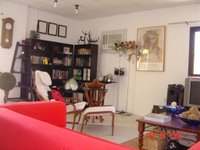
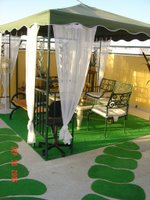
 Photographs of Pfeiffer-on-the-Roof, our flat in Riyadh (since August 2005).
Photographs of Pfeiffer-on-the-Roof, our flat in Riyadh (since August 2005).So-called in honor of our second cat, Pfeiffer.
Our first cat, Merrill, is honored in the name we gave to our home in Binan, Laguna -- Merrill Court. There's a third cat in the family; weve named her Stein.
No property has so far been named after her.



